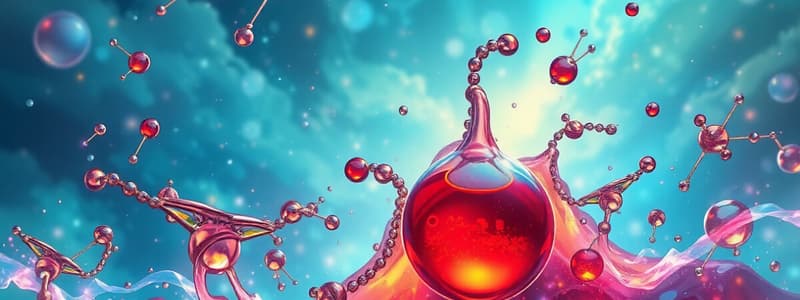Podcast
Questions and Answers
What term refers to the maximum amount of solute that can dissolve in a given amount of solvent at a specific temperature and pressure?
What term refers to the maximum amount of solute that can dissolve in a given amount of solvent at a specific temperature and pressure?
- Colligative Properties
- Concentration
- Molarity
- Solubility (correct)
Colligative properties are dependent on the identity of the solute.
Colligative properties are dependent on the identity of the solute.
False (B)
What is the relationship between temperature and the solubility of solids in liquids?
What is the relationship between temperature and the solubility of solids in liquids?
Generally, the solubility of solids in liquids increases with temperature.
The substance present in the largest amount in a solution is called the ______.
The substance present in the largest amount in a solution is called the ______.
Match the following concentration units with their definitions:
Match the following concentration units with their definitions:
Which of the following factors decreases the solubility of gases in liquids?
Which of the following factors decreases the solubility of gases in liquids?
The process of dissolution involves the interaction between solvent and solute molecules.
The process of dissolution involves the interaction between solvent and solute molecules.
What is the effect of a nonvolatile solute on the boiling point of a solvent?
What is the effect of a nonvolatile solute on the boiling point of a solvent?
According to Henry's Law, solubility of gases in liquids is directly proportional to ______.
According to Henry's Law, solubility of gases in liquids is directly proportional to ______.
Match the following types of solutions with their examples:
Match the following types of solutions with their examples:
What is the primary factor that drives dissolution of a solute in a solvent?
What is the primary factor that drives dissolution of a solute in a solvent?
Strong electrolytes only partially dissociate into ions in solution.
Strong electrolytes only partially dissociate into ions in solution.
What do you call the solid formed in a precipitation reaction?
What do you call the solid formed in a precipitation reaction?
Weak electrolytes ____ dissociate into ions in solution.
Weak electrolytes ____ dissociate into ions in solution.
Match the following terms with their definitions:
Match the following terms with their definitions:
Which of the following statements about precipitation reactions is correct?
Which of the following statements about precipitation reactions is correct?
Entropy decreases when a solute dissolves in a solvent.
Entropy decreases when a solute dissolves in a solvent.
What is necessary for predicting precipitation reactions?
What is necessary for predicting precipitation reactions?
Electrolytes are substances that dissolve in water to form solutions that ____ electricity.
Electrolytes are substances that dissolve in water to form solutions that ____ electricity.
Which factor does NOT favor dissolution?
Which factor does NOT favor dissolution?
Flashcards
Solution
Solution
A homogeneous mixture of two or more substances where the component present in the largest amount is the solvent and the other components are solutes.
Solvent
Solvent
The substance present in the largest amount in a solution.
Solute
Solute
The substance dissolved in a solvent.
Solubility
Solubility
Signup and view all the flashcards
Dissolution
Dissolution
Signup and view all the flashcards
Colligative Property
Colligative Property
Signup and view all the flashcards
Vapor Pressure Lowering
Vapor Pressure Lowering
Signup and view all the flashcards
Boiling Point Elevation
Boiling Point Elevation
Signup and view all the flashcards
Freezing Point Depression
Freezing Point Depression
Signup and view all the flashcards
Osmotic Pressure
Osmotic Pressure
Signup and view all the flashcards
Enthalpy Changes in Dissolution
Enthalpy Changes in Dissolution
Signup and view all the flashcards
Entropy in Dissolution
Entropy in Dissolution
Signup and view all the flashcards
Electrolytes
Electrolytes
Signup and view all the flashcards
Strong Electrolytes
Strong Electrolytes
Signup and view all the flashcards
Weak Electrolytes
Weak Electrolytes
Signup and view all the flashcards
Non-Electrolytes
Non-Electrolytes
Signup and view all the flashcards
Precipitation Reactions
Precipitation Reactions
Signup and view all the flashcards
Precipitate
Precipitate
Signup and view all the flashcards
Solubility Rules
Solubility Rules
Signup and view all the flashcards
Study Notes
Types of Solutions
- Solutions are homogeneous mixtures of two or more substances. The substance present in the largest amount is the solvent, while the other substances are solutes.
- Solutions can exist in various states: solid (e.g., alloys), liquid (e.g., saltwater), or gas (e.g., air).
- The solvent's properties dictate the solution's overall properties, such as its boiling point and freezing point.
Factors Affecting Solubility
- Solubility is the maximum amount of solute that can dissolve in a given amount of solvent at a specific temperature and pressure.
- Several factors influence solubility:
- Temperature: Generally, solubility of solids in liquids increases with temperature. Gases become less soluble in liquids as temperature increases.
- Pressure: Solubility of gases in liquids is directly proportional to pressure (Henry's Law). Increased pressure increases the solubility of the gas.
- Nature of solute and solvent: "Like dissolves like" is a general rule. Polar solvents dissolve polar solutes, and nonpolar solvents dissolve nonpolar solutes.
Concentration Units
- Concentration expresses the amount of solute in a given amount of solvent or solution. Several units are used:
- Molarity (M): Moles of solute per liter of solution.
- Molality (m): Moles of solute per kilogram of solvent.
- Percentage by mass (% w/w): Mass of solute divided by mass of solution, multiplied by 100.
- Percentage by volume (% v/v): Volume of solute divided by volume of solution, multiplied by 100.
- Parts per million (ppm): Mass of solute divided by mass of solution, multiplied by 10^6.
- Parts per billion (ppb): Mass of solute divided by mass of solution, multiplied by 10^9.
Colligative Properties
- Colligative properties are properties of solutions that depend on the number of solute particles, not the identity of the solute.
- Vapor pressure lowering: The presence of a nonvolatile solute lowers the vapor pressure of the solvent.
- Boiling point elevation: The presence of a nonvolatile solute raises the boiling point of the solvent.
- Freezing point depression: The presence of a nonvolatile solute lowers the freezing point of the solvent.
- Osmotic pressure: The pressure required to prevent the net flow of solvent across a semipermeable membrane.
Solution Formation
- Dissolution is a process involving the interaction between the solvent and solute molecules.
- The driving forces behind dissolution include:
- Enthalpy changes associated with the breaking of solute-solute interactions, solvent-solvent interactions, and the formation of solvent-solute interactions.
- Entropy increases often favor dissolution. The increase in disorder when the solute and solvent mix generally contributes to the solubility.
Electrolytes
- Electrolytes are substances that dissolve in water to form solutions that conduct electricity.
- Strong electrolytes completely dissociate into ions in solution.
- Weak electrolytes partially dissociate into ions.
- Non-electrolytes do not dissociate into ions in solution.
Precipitation Reactions
- Precipitation reactions involve the formation of an insoluble solid (precipitate) when two solutions are mixed.
- The solid forms because of the low solubility of the product in that solvent. Knowledge of solubility rules is essential for predicting precipitation reactions.
Studying That Suits You
Use AI to generate personalized quizzes and flashcards to suit your learning preferences.




